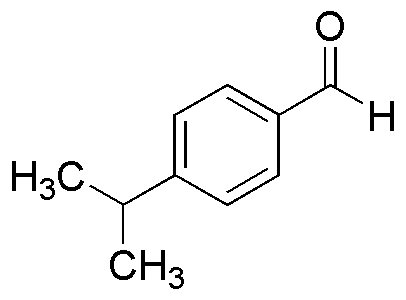Cuminaldehyde is widely utilized in research focused on:
- Flavor and Fragrance Industry: This compound is commonly used as a flavoring agent in food products and as a fragrance component in cosmetics and perfumes, providing a warm, spicy aroma that enhances sensory appeal.
- Pharmaceutical Applications: Cuminaldehyde exhibits antimicrobial properties, making it valuable in the development of natural preservatives and therapeutic agents for various infections.
- Aromatherapy: Its pleasant scent is utilized in essential oils and diffusers, promoting relaxation and well-being, which is increasingly sought after in wellness products.
- Research in Organic Synthesis: This compound serves as a building block in organic chemistry, facilitating the synthesis of more complex molecules, which is crucial for developing new materials and drugs.
- Natural Insect Repellent: Cuminaldehyde has shown efficacy in repelling certain pests, making it a potential ingredient in eco-friendly insect repellent formulations.
Informations générales
Propriétés
Sécurité et réglementation
Applications
Cuminaldehyde is widely utilized in research focused on:
- Flavor and Fragrance Industry: This compound is commonly used as a flavoring agent in food products and as a fragrance component in cosmetics and perfumes, providing a warm, spicy aroma that enhances sensory appeal.
- Pharmaceutical Applications: Cuminaldehyde exhibits antimicrobial properties, making it valuable in the development of natural preservatives and therapeutic agents for various infections.
- Aromatherapy: Its pleasant scent is utilized in essential oils and diffusers, promoting relaxation and well-being, which is increasingly sought after in wellness products.
- Research in Organic Synthesis: This compound serves as a building block in organic chemistry, facilitating the synthesis of more complex molecules, which is crucial for developing new materials and drugs.
- Natural Insect Repellent: Cuminaldehyde has shown efficacy in repelling certain pests, making it a potential ingredient in eco-friendly insect repellent formulations.
Documents
Fiches de données de sécurité (FDS)
La FDS fournit des informations de sécurité complètes sur la manipulation, le stockage et l’élimination du produit.
Spécifications du produit (PS)
Le PS fournit une description complète des propriétés du produit, notamment sa composition chimique, son état physique, sa pureté et les exigences de stockage. Il détaille également les plages de qualité acceptables et les applications prévues du produit.
Certificats d'analyse (COA)
Recherchez des certificats d'analyse (COA) en saisissant le numéro de lot du produit. Les numéros de lot et de lot se trouvent sur l'étiquette d'un produit, après les mots « Lot » ou « Lot de fabrication ».
Numéro de catalogue
Numéro de lot/série
Certificats d'origine (COO)
Ce certificat d'exploitation confirme le pays dans lequel le produit a été fabriqué, et détaille également les matériaux et composants utilisés et s'il est issu de sources naturelles, synthétiques ou autres sources spécifiques. Ce certificat peut être requis pour les douanes, le commerce et la conformité réglementaire.
Numéro de catalogue
Numéro de lot/série
Fiches de données de sécurité (FDS)
La FDS fournit des informations de sécurité complètes sur la manipulation, le stockage et l’élimination du produit.
DownloadSpécifications du produit (PS)
Le PS fournit une description complète des propriétés du produit, notamment sa composition chimique, son état physique, sa pureté et les exigences de stockage. Il détaille également les plages de qualité acceptables et les applications prévues du produit.
DownloadCertificats d'analyse (COA)
Recherchez des certificats d'analyse (COA) en saisissant le numéro de lot du produit. Les numéros de lot et de lot se trouvent sur l'étiquette d'un produit, après les mots « Lot » ou « Lot de fabrication ».
Numéro de catalogue
Numéro de lot/série
Certificats d'origine (COO)
Ce certificat d'exploitation confirme le pays dans lequel le produit a été fabriqué, et détaille également les matériaux et composants utilisés et s'il est issu de sources naturelles, synthétiques ou autres sources spécifiques. Ce certificat peut être requis pour les douanes, le commerce et la conformité réglementaire.


